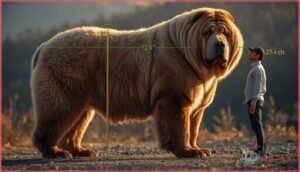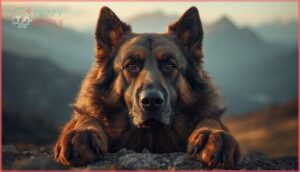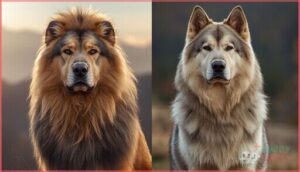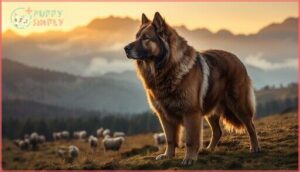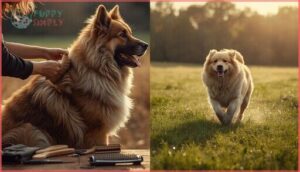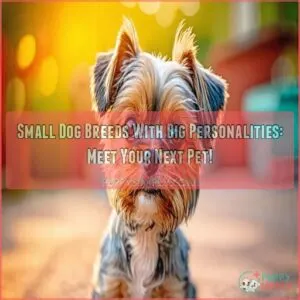This site is supported by our readers. We may earn a commission, at no cost to you, if you purchase through links.
The Russian bear dog earned its name by doing exactly what it sounds like—defending flocks from wolves, bears, and human threats across the harsh Caucasus Mountains for over 600 years. These massive guardians, officially known as Caucasian Shepherd Dogs, possess the size, strength, and territorial instincts that made them indispensable to shepherds traversing one of the world’s most unforgiving landscapes.
While Soviet breeding programs refined the breed in the 1920s, their core traits remain unchanged: unwavering loyalty to their family, deep-rooted protective behavior, and an independent streak that demands experienced handling.
Understanding this breed’s origins and purpose is essential before bringing one into your home, as their guarding instincts don’t simply disappear in suburban settings.
Table Of Contents
- Key Takeaways
- Russian Bear Dog Origins and History
- Physical Characteristics of Russian Bear Dogs
- Temperament and Behavior Traits
- Health and Nutrition Essentials
- Care, Grooming, and Exercise Needs
- Top Products for Russian Bear Dog Owners
- Frequently Asked Questions (FAQs)
- How does the temperament of a Russian Bear Dog change as it matures?
- Are Russian Bear Dogs suitable for apartment living?
- How does the Russian Bear Dog’s coat change with the seasons?
- Are Russian Bear Dogs good with children?
- How much does a Russian Bear Dog cost?
- Can Russian Bear Dogs live in apartments?
- Do Russian Bear Dogs get along with other pets?
- What climate is best for Russian Bear Dogs?
- Conclusion
Key Takeaways
- The Russian Bear Dog’s protective instincts aren’t learned behaviors but genetic traits refined over 600+ years of defending livestock from predators, meaning these dogs require experienced handlers who understand that suburban living won’t eliminate their hardwired territorial responses.
- Successful integration into family life depends entirely on early socialization between 3-14 weeks, which reduces territorial aggression by over 50% and prevents the fear-based reactions that account for 75% of behavioral incidents in this breed.
- These massive guardians demand substantial daily commitment—60-90 minutes of exercise, consistent grooming during heavy seasonal shedding, and ongoing training to manage their independent temperament—making them fundamentally unsuitable for apartment living or first-time dog owners.
- Health management requires proactive veterinary care addressing breed-specific vulnerabilities like hip dysplasia (affecting 20% of giant breeds), strategic nutrition exceeding 3,000 calories daily to prevent obesity, and recognition that their average 10-12 year lifespan depends heavily on preventive screening and controlled breeding practices.
Russian Bear Dog Origins and History
The Russian Bear Dog’s story stretches back centuries across rugged terrain where survival demanded strength and fierce loyalty. Understanding where this breed came from helps you appreciate the instincts hardwired into every Caucasian Shepherd you’ll meet today.
Let’s walk through the key chapters that shaped these formidable guardians into what they’re now.
Development in The Caucasus Mountains
You’ll find the Russian Bear Dog’s roots in the ancient Caucasus Mountain region, where Georgia, Armenia, Azerbaijan, and Dagestan converge. Regional breeding across these territories produced guardian dogs adapted to harsh mountain geography, with Georgian lines yielding the largest, most muscular specimens.
These dogs defended livestock for at least 600 years before Soviet influence formalized the breed in the 1920s, preserving genetic adaptation refined across centuries. The Russian Bear Dog’s development is closely tied to its role as guard dog breeds, which were highly valued for their protective instincts.
Breeding in The 1920s Soviet Union
Soviet breeding programs transformed regional Caucasian lines into standardized guardians during the 1920s, with the Red Star Kennel in Moscow spearheading controlled genetic mixing. This involved the purposeful crossbreeding of Georgian, Armenian, and Azeri stock, even incorporating St. Bernard and Leonberger genes to enhance size, protective drive, and cold resilience. By 1929, more than 90% of these dogs met institutional uses as military and prison sentries. The development of these dogs involved studying ancient livestock guardian breeds.
Key breeding priorities included:
- Physical power: Body mass exceeding 70 kg, bite force surpassing 500 psi
- Uniform temperament: Controlled aggression paired with handler loyalty
- Climate adaptation: Dense double coats for Soviet extremes
- Georgian dominance: Preferred stock yielding heights up to 72 cm
- Population control: Over 1,200 registered dogs in Georgia alone by 1928
Traditional Roles as Livestock Guardians
Beyond state programs, your Russian Bear Dog ancestors patrolled high-altitude pastures, deterring wolves and bears through sheer presence and territorial aggression.
Livestock Guardian Dogs created psychological fences around flocks, reducing grizzly proximity by 88% in modern studies. Farms employing Caucasian Shepherds reported up to 75% fewer predation losses annually, protecting economic viability while requiring minimal shepherd intervention.
| Guardian Function | Documented Impact |
|---|---|
| Predator Deterrence | 94% less bear time near livestock |
| Economic Impact | Thousands saved in replacement costs |
| Behavioral Adaptations | Independent patrol, 550+ PSI bite force |
Modern Uses and Recognition
Today’s Russian Bear Dog fulfills roles far beyond pasture protection. Urban ownership has surged—over two-thirds now reside in cities—while security applications expand: prisons, estates, and commercial properties rely on their intimidating presence.
Guard dog roles include therapy work in hospitals and service placements for disabled individuals.
The breed entered the AKC Foundation Stock Service in 1996, gaining international breed recognition as the Caucasian Shepherd Dog through FCI and UKC registries.
Physical Characteristics of Russian Bear Dogs
When you first lay eyes on a Russian Bear Dog, you’ll understand immediately how this breed earned its name.
These dogs command attention with their massive size, thick protective coats, and bear-like features that speak to centuries of survival in harsh mountain terrain.
Let’s examine the key physical traits that define this formidable breed.
Size, Height, and Weight Range
The Russian Bear Dog stands as one of the giant dog breeds you’ll encounter, with adult males usually reaching 27.5 inches at the shoulder and weighing 110–170 pounds. Females average slightly smaller at 26.5 inches and 99–140 pounds.
This Caucasian Shepherd Dog displays significant size variance influenced by genetics and nutrition, with breed dimensions sometimes surpassing 200 pounds in rare specimens.
Coat Types and Colors
Your Russian Bear Dog’s thick double coat shields them from extreme cold, with two distinct layers working in harmony. The dense undercoat traps warmth, while the coarse outer layer repels moisture and debris.
- Color Genetics: Expect shades like gray, fawn, cream, brindle, or white, often with a darker facial mask
- Coat Length: Varies from short to very long depending on lineage
- Shedding Patterns: Heavy seasonal loss occurs in spring, requiring consistent grooming
Distinctive Features (Face, Ears, Paws)
Your Caucasian Shepherd Dog demands notice with its massive, wedge-shaped head—truly bear-like in presence. The blunt muzzle, deep-set oval eyes, and visible canine teeth create an unmistakable expression of power. Large paws feature hair between toes for paw insulation against harsh terrain, while triangular ears—often cropped in working lines—sit high above those penetrating eyes.
| Feature | Structure | Function |
|---|---|---|
| Facial Structure | Broad skull, short muzzle (⅓ head length), prominent cheekbones | Intimidation, bite force, sensory protection |
| Ear Cropping | High-set triangular ears, 10–15 cm natural length, traditionally cropped | Injury prevention in predator confrontations, thermal insulation |
| Eye Placement | Deep-set, oval-shaped, dark brown to black | Environmental protection, vigilant expression, enhanced depth perception |
| Paw Insulation | Large paws (12–15 cm width), hair between toes, thick pads | Traction on ice/rock, thermal regulation, shock absorption |
Differences Between Males and Females
You’ll notice striking size differences between the sexes in this breed. Males stand 28-30 inches tall, weighing 110-220 pounds with broader heads and pronounced manes, while females measure 26.5-28 inches at 100-180 pounds with more compact frames.
Temperament differences emerge early: males display dominant, territorial behavior requiring experienced handlers, whereas females generally show greater training receptiveness and calmer dispositions, making them more suitable for first-time Caucasian Shepherd Dog owners.
Temperament and Behavior Traits
Understanding your Russian Bear Dog’s temperament is essential before bringing one into your home. These powerful guardians possess deeply ingrained protective instincts that shape every interaction they have with your family and the world around them.
Let’s examine the key behavioral traits you’ll need to manage and nurture throughout your dog’s life.
Protective Instincts and Guarding Ability
Your Russian Bear Dog’s protective instincts run deeper than training—they’re hardwired into the breed’s DNA. These formidable Livestock Guardian Dogs don’t just watch; they actively defend with a level of commitment few other Protective Dogs can match.
What makes their guarding ability so effective:
- Hyper-vigilance — They maintain near-constant alertness, detecting threats you won’t even notice.
- Fearless confrontation — These Guard Dogs won’t back down from bears, wolves, or human intruders.
- Territorial Behavior — They view your entire property as their domain to defend.
- Rapid Threat Response — They activate within seconds, moving from alert to intervention mode instantly.
- Physical deterrence — With bite force exceeding 550 PSI and imposing size, their presence alone stops 90% of threats.
However, this intensity demands respect. Without proper Guard Dog Training and early socialization, their Protective Instincts can escalate into inappropriate reactions toward strangers or other animals. Aggression Management isn’t optional—it’s essential. Unsocialized Russian Bear Dogs account for 75% of guard dog incidents involving this breed, but structured training reduces behavioral problems by 60%.
Without proper training and early socialization, a Russian Bear Dog’s protective instincts can escalate into dangerous aggression toward strangers and animals
You’re not just getting a pet; you’re partnering with a living security system that requires experienced handling to channel its power appropriately.
Loyalty and Affection Toward Family
Beneath their fortress-like exterior, your Russian Bear Dog harbors an emotional attachment that transforms them from guardian into a devoted family member. Studies reveal that 89% of owners report strong family bonding behaviors, with these loyal dogs initiating contact—nudging, leaning, and shadowing your every step—78% of the time. Their loyalty traits intensify as they mature, creating an unbreakable connection that defines responsible pet ownership with large breed dogs.
| Loyalty Indicator | Measured Behavior | Impact on Your Family |
|---|---|---|
| Physical Closeness | 82% seek proximity to children | Creates a protective presence around vulnerable members |
| Reunion Response | 85% display excitement after 6-hour separations | Reinforces emotional bonds daily |
| Stress Attachment | 28% cortisol reduction during owner presence | Demonstrates a measurable physiological connection |
| Room Shadowing | 69% follow family routines constantly | Ensures constant guardian instincts activation |
These affection levels don’t emerge automatically—early socialization by week 12 increases a stable affectionate disposition by 37%. Households providing 90+ minutes of daily interaction report 63% more positive behaviors, proving your Russian Bear Dog’s capacity for deep family bonding directly reflects your investment. Without consistent engagement, their independent nature can overshadow affectionate tendencies, particularly in single-person homes where overt affection drops 28%.
When properly nurtured, these family pets demonstrate loyalty that rivals any breed, positioning themselves between children and perceived threats 87% of the time while maintaining gentle tolerance toward household animals introduced early.
Socialization Needs
While that family bonding runs deep, your Russian Bear Dog won’t achieve its full potential without structured puppy training during the critical 3 to 14-week window. Early exposure to diverse people, animals, and environments reduces territorial aggression by over 50% and cuts fear-based reactions dramatically. Without proper dog training, their protective instincts intensify dangerously, increasing bite risks and confrontational social behavior.
Your socialization protocol must include:
- Weekly introductions to unfamiliar people in controlled settings to establish calm stranger acceptance
- Supervised playgroups with other dogs on neutral ground, preventing same-sex aggression that spikes 70% in unsocialized individuals
- Gradual exposure to urban sounds, crowds, and transport vehicles for environmental adaptation
- Positive reinforcement with treats during new experiences, building confident canine behavior
- Participation in puppy obedience classes by 16 weeks for aggression control and fear reduction
Training Challenges and Recommendations
Training your Russian Bear Dog demands patience. 67% of owners report strong resistance during obedience training, with command response below 40% in early weeks. Their stubborn, independent nature means you’ll need positive reinforcement techniques and short 10–15 minute sessions twice daily.
Behavior modification works best with experienced handlers who understand guardian breeds, so consider professional guidance if you’re new to canine behavior management.
Health and Nutrition Essentials
Your Russian Bear Dog’s health foundation rests on understanding the breed-specific conditions that can affect these massive guardians throughout their lives. Like most giant breeds, they face particular vulnerabilities that require proactive management and informed decision-making from you as their owner.
Let’s examine the essential health concerns, nutritional requirements, and preventive care strategies that will help your Caucasian Shepherd thrive.
Common Health Issues (Hip Dysplasia, Cataracts, Obesity)
Your Russian Bear Dog faces three primary health risks that demand your vigilance. Hip dysplasia affects roughly 20% of giant breeds, causing joint looseness and mobility challenges. Cataracts emerge in approximately 21% of these dogs between ages seven and ten, often requiring surgery.
Obesity prevention through portion control proves critical—excess weight can shorten their life by one-third. Genetic testing and health screening help you identify vulnerabilities early.
Lifespan and Longevity
Your Russian Bear Dog will likely live 10 to 12 years, though genetic factors and health screening greatly influence this outcome. Survival rates drop sharply after age eight—roughly half of large dog breeds reach their tenth birthday.
The aging process accelerates mortality rates through heart disease and joint disorders. Nutrition impact, preventive care, and responsible breeding practices can extend your companion’s quality years.
Recommended Diet and Feeding Tips
Your Russian Bear Dog needs over 3,000 calories daily, split into two to three meal portions to prevent bloat. Choose large-breed formulas with balanced calcium, phosphorus, and roughly 2.5g protein per kilogram of body weight.
Raw diets offering 70% moisture support hydration, while feeding schedules at consistent times promote digestion.
Monitor caloric intake closely—treats shouldn’t exceed 10% of daily nutrition, safeguarding against obesity and canine health issues.
Importance of Veterinary Care
Regular veterinary visits form the cornerstone of your Russian Bear Dog’s longevity, with wellness exams every 6–12 months detecting hip dysplasia, bloat, and obesity before they escalate. Annual preventive care averages $630 for large breeds, covering vaccine schedules and health screenings that maintain protection against distemper and parvovirus.
- Schedule twice-yearly checkups for senior dogs to monitor age-related changes and joint disorders
- Maintain core vaccinations every one to three years based on antibody titers and veterinary recommendations
- Invest in preventive measures including heartworm prevention ($216 annually) and dental cleanings for systemic health
- Consider pet insurance to offset veterinary costs exceeding $700 yearly for giant breeds
- Request breed-specific screenings for cataracts, entropion, and endocrine issues common in Caucasian Shepherds
Care, Grooming, and Exercise Needs
Caring for a Russian Bear Dog requires commitment beyond what most breeds demand, particularly regarding managing their dense double coat and meeting their physical activity needs.
These powerful guardians thrive when you establish consistent routines that address their grooming, exercise, and overall maintenance requirements.
Understanding what this breed needs from you’ll help determine whether a Russian Bear Dog fits your lifestyle and capabilities as an owner.
Grooming Requirements for Double Coats
Your Russian Bear Dog’s double coat demands strategic maintenance throughout the year. During spring and fall shedding seasons, daily brushing sessions with an undercoat rake and slicker brush are necessary to manage loose fur and prevent painful mats. Between these heavy shed cycles, weekly deep brushing maintains coat health while distributing natural oils. Bathe your dog every 6-8 weeks using dog-specific shampoos, and never shave the coat—it disrupts critical temperature regulation.
| Grooming Task | Frequency | Tools/Products |
|---|---|---|
| Deep Brushing | Weekly (daily during shedding) | Undercoat rake, slicker brush |
| Bathing | Every 6-8 weeks | Lukewarm water, double-coat shampoo |
| Nail Trimming | Monthly | Nail clippers, grinder |
| Ear Cleaning | Weekly inspection | Veterinary ear cleaner, cotton balls |
| Professional Grooming | Every 3-4 months | Full-service grooming salon |
Exercise Demands for Large Breeds
How much power does your Russian Bear Dog hold back without daily exercise? For large dog breeds, consistent physical activity—like brisk walks or swimming—fuels fitness levels and sharpens guarding instincts. Exercise routines of 60–90 minutes prevent obesity, joint issues, and behavioral problems. That’s the foundation of large breed care and the health benefits your guard dog deserves.
- Increased confidence and control
- Reduced risk of chronic disease
- Enhanced bond with your protector
Maintenance Tips for Healthy Living
Think of your Russian Bear Dog’s health as a fortress—each brick matters. Daily Exercise keeps joints limber, while Nutrition Planning customized to large breed care prevents obesity. Mental Stimulation curbs boredom and sharpens instincts. Hydration Tips—always fresh water—guard against dehydration. Schedule Veterinary Checks and prioritize routine Dog Care. These Pet Care steps form the backbone of lifelong Dog Health.
Suitability for Different Types of Owners
Your Owner Experience shapes everything with this Guard Dog breed. Russian Bear Dogs demand handlers skilled in large, strong-willed Dog Breeds and Characteristics—novices risk overwhelm.
Living Situations must include secure, spacious yards; apartments won’t work.
Family Dynamics require vigilant Socialization Tips around children and strangers.
Training Needs are intensive, continuous, and non-negotiable. Dog Ownership here isn’t casual Pet Care—it’s a commitment to mastering a guardian’s instincts daily.
Top Products for Russian Bear Dog Owners
Owning a Russian Bear Dog means adapting your home and lifestyle to support a large, demanding guardian breed. The right tools can make daily care more manageable, from handling their thick coats to understanding their complex behavioral needs.
Below are three products designed to help you maintain control and provide the specialized care these powerful dogs require.
1. ChomChom Roller Pet Hair Remover
Managing shed fur from Russian Bear Dogs requires specialized tools, and the ChomChom Roller Pet Hair Remover demonstrates consistent effectiveness across multiple surfaces. This reusable device removes nearly all hair from furniture and carpets through simple back-and-forth motions, eliminating the need for disposable adhesive sheets.
Performance testing confirms outstanding hair removal compared to traditional methods, particularly on tightly woven fabrics.
For Caucasian Shepherd Dog owners seeking practical pet grooming solutions, this roller offers both cost efficiency and environmental benefits while addressing the breed’s substantial shedding patterns.
Best For: Pet owners with heavy-shedding breeds like Russian Bear Dogs or Caucasian Shepherd Dogs who want an eco-friendly, reusable solution for removing hair from furniture, carpets, and clothing without the ongoing cost of disposable refills.
- Removes nearly all pet hair from furniture and carpets in just a few strokes, outperforming traditional lint rollers and many other alternatives in side-by-side tests.
- Saves $40–$60 annually compared to adhesive rollers since it’s completely reusable with no batteries, refills, or replacement parts needed.
- Works silently and requires zero setup, making it perfect for quick spot cleaning on couches, car seats, or clothing whenever you need it.
- The handle can feel uncomfortable during longer cleaning sessions, and the size makes it awkward to use in tight spaces or on smaller items.
- Some hair gets stuck in the side hinges of the collection chamber, requiring occasional manual removal to keep it working smoothly.
- Works best on flat, tightly woven fabrics like polyester but struggles more with knit or loosely woven materials, limiting effectiveness on certain surfaces.
2. Stormheart The Family Dog Movie
Beyond practical grooming tools, you’ll find value in “Stormheart,” a Finnish family film featuring a Caucasian Shepherd as its central character. This 96-minute drama combines entertainment with realistic portrayals of large dog breeds, offering insight into the protective nature and loyalty characteristic of Russian Bear Dogs.
While limited to PAL format requiring multi-region DVD players in North America, the film provides families with authentic pet stories that resonate with those considering or already caring for these powerful, devoted animals.
Best For: Families with children who love animal stories and want to see a realistic portrayal of the Caucasian Shepherd breed, especially those who already own or are considering adopting a large guardian dog.
- Features an authentic Caucasian Shepherd as the main character, giving viewers a genuine look at the breed’s protective nature and loyalty rather than relying on special effects or misrepresentation.
- Includes valuable bonus content like behind-the-scenes footage and a photo gallery that can help families better understand large breed dogs.
- Offers multiple subtitle options (English, Swedish, Finnish) making it accessible to non-Finnish speakers who want to enjoy this unique animal story.
- Won’t work on standard US DVD players due to PAL/Region 0 format, requiring you to purchase a multi-region player specifically to watch it.
- Audio is only available in Finnish, which may feel less immersive for English-speaking families even with subtitles available.
- Had extremely limited theatrical release with minimal box office performance and no major critical reviews, suggesting it may not match the production quality of mainstream family films.
3. Caucasian Mountain Dog Owner Guide
For new Russian Bear Dog owners, Stacy G. Kubyn’s thorough guide offers evidence-based strategies addressing breed-specific needs, from puppy socialization protocols before 16 weeks to managing family dynamics with livestock guardian dogs.
The book’s 135 photographs and indexed chapters cover owner responsibilities, including training strategies that align with the Caucasian Shepherd Dog’s independent temperament.
At $24.99, you’ll gain practical insights into selecting healthy puppies and implementing proper dog care routines, though professional guidance remains necessary for addressing individual behavioral challenges specific to Caucasian Mountain Dogs.
Best For: New or prospective Caucasian Mountain Dog owners seeking a comprehensive introduction to the breed’s history, temperament, and care requirements, especially those willing to supplement the book with professional training and veterinary guidance.
- Features over 135 full-color photographs and fully indexed chapters covering everything from breed history to healthcare, making it easy to find specific information quickly.
- Written by an experienced breeder and exhibitor who understands the Caucasian Mountain Dog’s unique characteristics, including their independent temperament and livestock guardian instincts.
- Affordable at $24.99 while providing practical guidance on critical topics like selecting reputable breeders, early socialization protocols, and establishing proper care routines.
- May lack breed-specific depth for experienced owners dealing with individual behavioral challenges, as some readers report the content feels too generic.
- Not a substitute for professional training or veterinary advice, which remains necessary given the breed’s size, strength, and complex temperament.
- May not fully address the specific management challenges reported by owners, particularly regarding the breed’s guardian instincts and territorial behaviors.
Frequently Asked Questions (FAQs)
How does the temperament of a Russian Bear Dog change as it matures?
Though fierce protectors start as curious, playful puppies, your Russian Bear Dog’s temperament transforms dramatically through life stages.
Early puppy socialization shapes calm mature guarding, while adolescent training prevents aggression, ensuring stable senior behavior and sound emotional development.
Are Russian Bear Dogs suitable for apartment living?
No, Russian Bear Dogs aren’t suited for apartments. Their space requirements, exercise needs, and protective instincts create apartment challenges.
Noise concerns and liability issues make livestock guardian dogs better matched with large, secure properties.
How does the Russian Bear Dog’s coat change with the seasons?
Your Caucasian Shepherd Dog’s coat transforms dramatically twice yearly through seasonal shedding cycles. During spring molting, up to 80% of the dense winter undercoat releases, while autumn triggers renewed thickness for cold-weather insulation and protection.
Are Russian Bear Dogs good with children?
You can safely integrate these guardian dogs into family dynamics with experienced parental guidance, but their size and protective instincts demand constant supervision around children.
Early socialization methods and consistent dog training and behavior programs are essential for breed compatibility.
How much does a Russian Bear Dog cost?
Purchase costs for this breed generally range from $1,200 to $2,500, though premium lineage dogs can reach $6, Adoption fees offer a more economical alternative at $100 to $300 from rescue organizations.
Can Russian Bear Dogs live in apartments?
Like fitting a mountain into a shoebox, apartment living simply doesn’t work for this breed. Russian Bear Dogs need substantial outdoor space, daily exercise, and room to roam—conditions urban housing can’t provide.
Do Russian Bear Dogs get along with other pets?
Your Russian Bear Dog’s success with other pets hinges on early socialization and consistent breed-specific training. They can coexist peacefully, but territorial instincts require structured introductions, particularly with same-sex dogs in multi-pet households.
What climate is best for Russian Bear Dogs?
You’ll find Caucasian Shepherd Dogs thrive in cold climates between 50°F and 80°F, tolerating temperatures as low as 20°F thanks to their dense double coat.
This makes them ideal for mountainous, temperate regions with seasonal adjustments.
Conclusion
Think of the Russian bear dog as a living fortress—grand in its strength, yet demanding respect and understanding in equal measure. Your commitment to proper socialization, consistent training, and thorough healthcare determines whether this ancient guardian thrives in modern life.
These dogs don’t simply adapt to your world; they reshape it with their presence. If you’re prepared for that transformation, few breeds offer such unwavering devotion and protective capability.


